Highlights of the Smart Software Shift
- Centralized Truth: Moving beyond scattered spreadsheets to a single source of project data drastically reduces errors and improves decision-making.
- Real-time Financial Control: Gain immediate insight into job costs and profitability, allowing for proactive adjustments rather than reactive damage control.
- Seamless Collaboration: Connect office and field teams with integrated workflows, ensuring everyone works from the most current information and minimizing miscommunication.
You know that feeling. It’s late, the job trailer hums with just your laptop, and you’re staring at a spreadsheet so tangled it could be a roadmap of a busy city at rush hour. Rows upon rows, formulas that seem to break if you even look at them wrong, and that nagging whisper: Is this actually right? Did I miss something important? Honestly, if that resonates with you, you're not alone. For a long time, spreadsheets were construction's dependable partner, a real workhorse. But let’s be frank—they were never designed for the chaotic, changing, and collaborative world of a construction site. They're more like a digital version of a paper ledger, and trying to run a multi-million-dollar project on one is a bit like using a handsaw to build a skyscraper. It might work, eventually, but it’s going to take ages, and your arm will certainly ache.
Good news, though: there’s a much better way to go about it. We’re not talking about fancy gadgets or anything overhyped. It's about using tools that actually fit the job, making your life simpler, not adding another complex system to your day. This shift isn't just about adopting new technology; it’s about embracing a mindset that values efficiency, accuracy, and collaboration from the ground up.
The Unseen Costs of Sticking with Spreadsheets
More than just a free tool, spreadsheets come with hidden expenses that pile up fast.
We often convince ourselves that spreadsheets are free. But they're really not. The true cost hides in the hours your team spends manually updating them, the small errors that slip through the cracks, and all the opportunities you miss because you’re knee-deep in data entry instead of leading your crew. Think about it: the last time a change order came in, how many different spreadsheets did you have to touch? Your budget tracker, the purchase order log, the client invoice. One little change often creates a ripple effect of manual work, and each time you copy and paste, you risk a mistake. These aren't just minor typos; they can be oversights costing thousands of dollars, just waiting to happen.
And collaboration? Forget about it. Email chains with ten different versions of the same file are a genuine nightmare. You’re never quite sure if everyone’s actually looking at the very latest data. This creates a lot of confusion, slows down decisions, and frankly, it just exhausts everyone involved. It’s like trying to conduct an orchestra with everyone playing a different sheet of music; the result is chaos, delays, and often, unexpected costs.
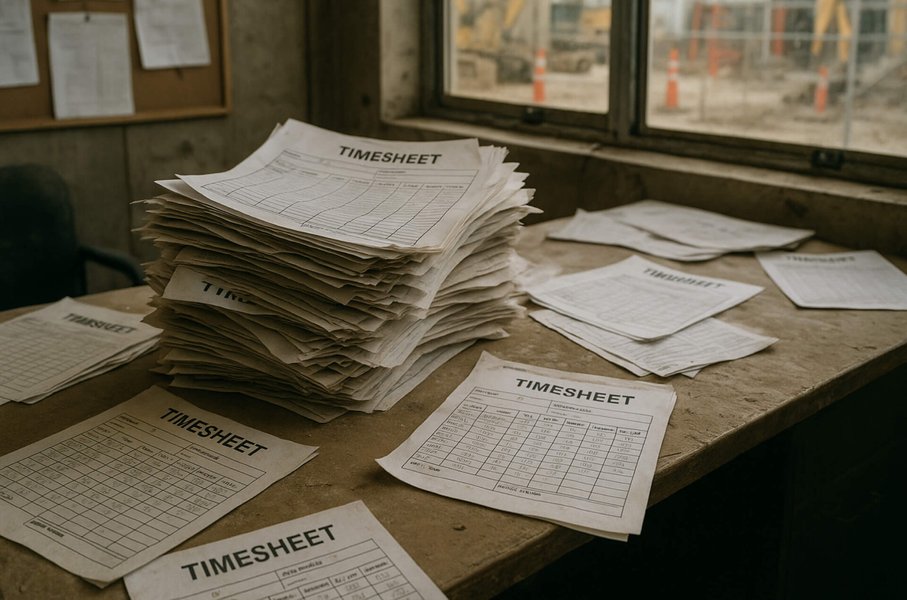
The messy reality of manual processes can easily hide crucial details.
What Smart Software Brings to the Table
Beyond automation, it’s about a connected ecosystem for your projects.
This isn’t about just doing things faster; it’s about doing them smarter. Modern construction management software, like Archdesk, builds a single source of truth for your entire project. Imagine this instead: a change order gets approved. The software automatically updates your budget, alerts your project manager, and generates a revised timeline. Your subcontractors see the update instantly on their phones. All financials reflect the change in real-time. There’s no frantic emailing, no version control headaches. Everything just connects.
It’s not magic; it’s just intelligent design. These platforms bring your office and field teams together onto one connected system. Your project manager can view live progress photos straight from the site, while your foreman can access the latest drawings and task lists without chasing anyone down. It cuts out all the noise and lets everyone focus on what they do best: building.
Real-time Job Costing and Financial Visibility
One of the biggest shifts is in how you see your money. With smart software, you move from historical reporting to real-time job costing. You can see your true project profitability as it happens, not weeks or months later. This means you can react quickly to budget variances and make informed decisions, protecting your margins.
Streamlined Document Management and Communication
Say goodbye to the "which version is it?" dilemma. RFIs, submittals, drawings, and revisions all live in one central, secure place. Every team member accesses the most current files, and a clear version history means you always know who changed what, when, and why. This kind of centralized data environment helps connect your entire project community, reducing rework and errors, and smoothing collaboration from owners to subcontractors.
Enhanced Field Operations
Field teams get mobile access to critical information, meaning daily reports, photos, punch lists, time tracking, and material logs can all be recorded right from their phones. Dashboards provide an instant snapshot of project status, allowing project managers to keep a pulse on progress without being physically on site all the time. This mobile connectivity means fewer delays and better accountability.
Integrated Scheduling and Resource Management
Scheduling gets a serious upgrade. Tasks, dependencies, and manpower can all be viewed against project plans, and reasons for delays are documented, not guessed. This integration helps you predict potential bottlenecks and allocate resources more effectively, keeping projects on track and on budget.
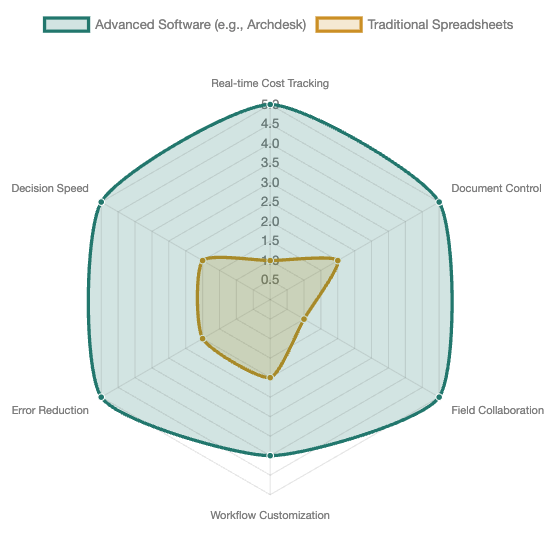
This radar chart compares key performance indicators between advanced construction management software and traditional spreadsheets, showing a clear advantage in efficiency and capability for integrated solutions.
Why Construction Leaders are Making the Switch Now
It boils down to two simple things: margin and managing risk.
Honestly, two straightforward reasons compel leaders to switch: margin and risk. Industry guides and software reviewers point to a consistent pattern this year: companies that connect cost, documents, and field data make quicker decisions and significantly reduce rework. While many still like spreadsheets for quick scratch work, they’re choosing robust platforms as their live system of record. Why? Because the construction industry is tough enough without fighting your own tools. It’s about fewer surprises and healthier margins.
Here’s a look at how different aspects of project management are impacted by this upgrade:
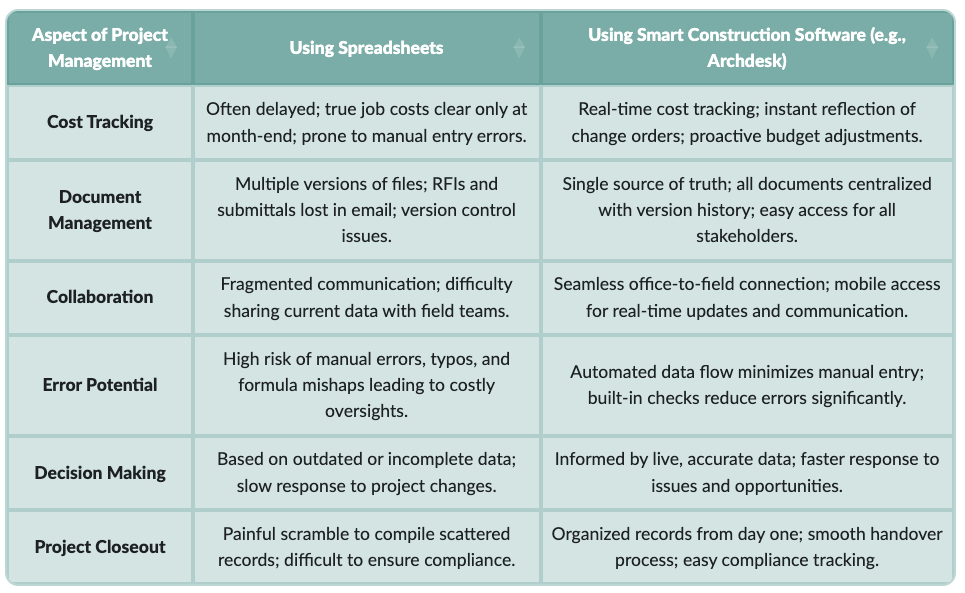
Archdesk: Built for Your Construction Workflow
Designed to adapt to how you work, not force you into a rigid system.
Now, you might be looking at some of the bigger names out there—Procore, Autodesk Construction Cloud, Buildertrend. They’re excellent tools, no doubt. But sometimes, they feel like you have to change your entire business to fit their software. Often, they’re built for massive enterprise projects, which can leave smaller to mid-sized firms feeling a bit overwhelmed, like buying a monster truck for errands.
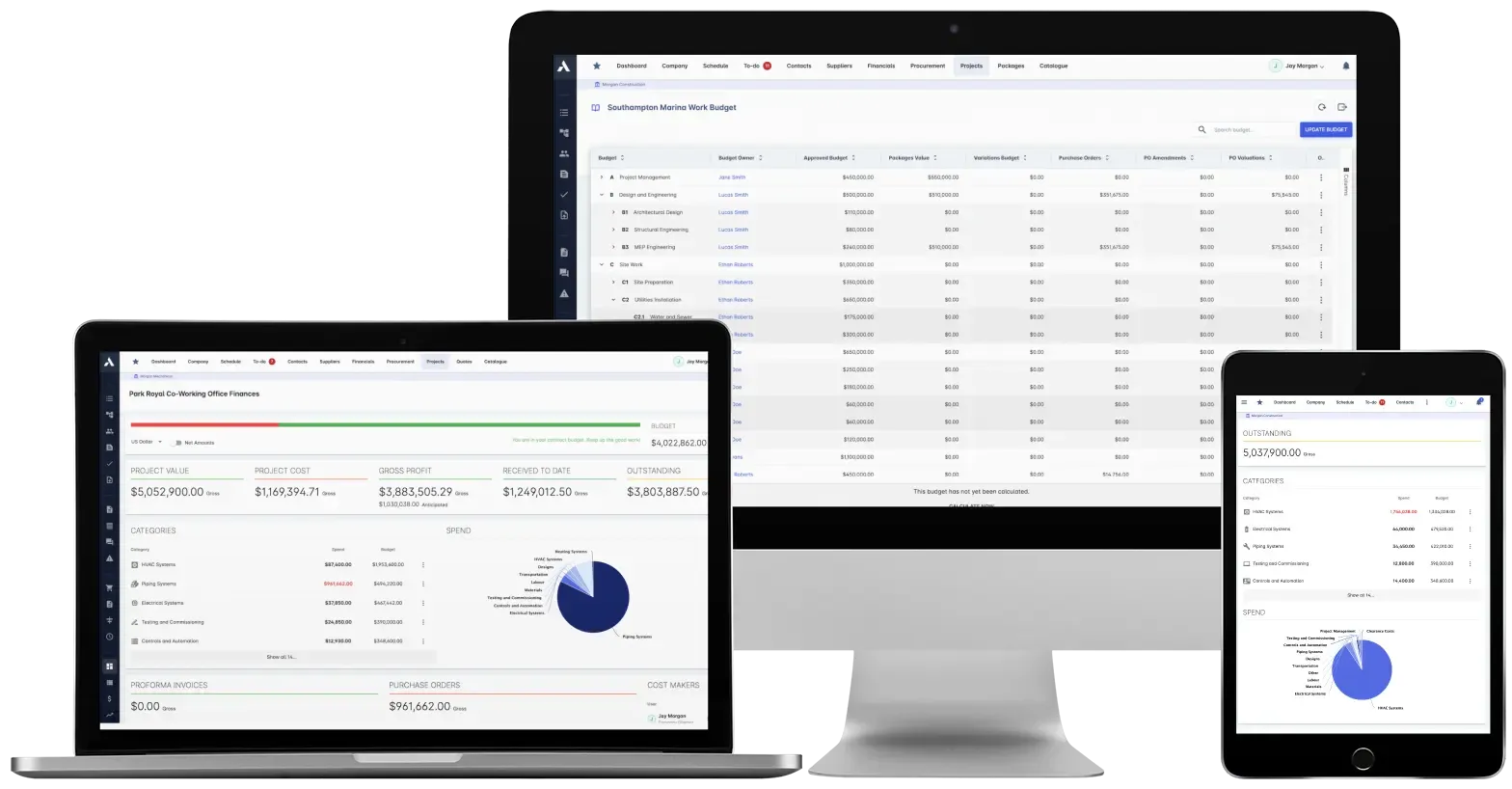
Archdesk provides a comprehensive, at-a-glance view of your project's health.
Archdesk is different, though. It’s made to be flexible, to adapt to your existing workflows, not the other way around. It understands that a residential remodel doesn’t run quite the same way as a big commercial ground-up build. It gives you all the power of a full financial suite, tightly integrated with your project management, so you finally get a clear picture of your profitability on every single job. You get the robust features you genuinely need without all the complexity you don’t. It feels familiar, not foreign. The whole goal is to make your life easier, not just add another complicated system to your day.
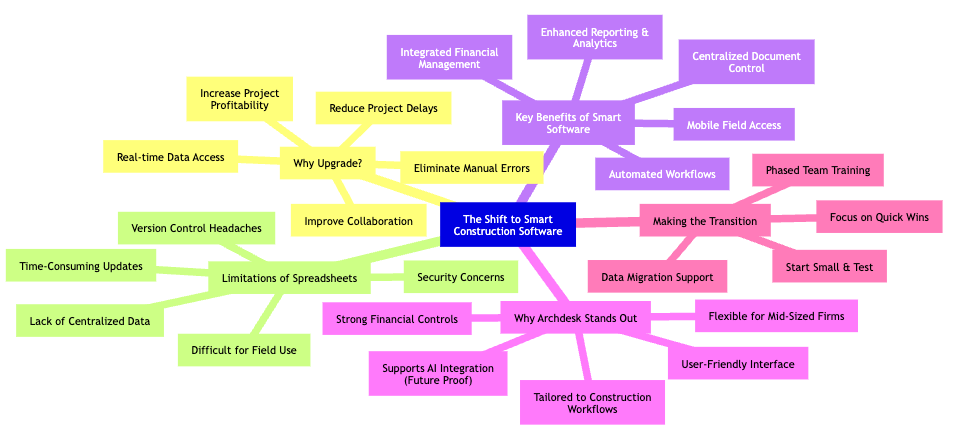
This mindmap illustrates the journey from traditional spreadsheets to intelligent construction management software, highlighting the problems solved and the advantages gained by embracing a dedicated platform like Archdesk.
Navigating the Transition to a Smarter System
It’s not as scary as it sounds, honest.
The idea of moving years of data probably feels like the biggest hurdle, doesn't it? It seems like a massive project in itself. But the best software companies make this much simpler than you might think. They help you transition gradually, often by starting with just one project or one team. You don’t have to flip a switch and change everything overnight. Maybe start by moving your project scheduling or your financial tracking. See how it feels, get a sense of it. Once you experience that moment of clarity—that "aha!" moment when you see your entire project’s health on one dashboard—you’ll honestly wonder how you ever managed without it.
A Phased Approach to Adoption
Keep it simple. You could begin by mapping your current processes, from estimate to change order to invoice, or from an RFI to a drawing revision. Then, import your cost codes, vendors, and templates. Solutions like Archdesk often support migration, so your established naming conventions and structures can stay familiar. Train your field leads first; if a foreman can log work, attach photos, and raise issues in just a minute, adoption tends to stick. Then, connect accounting, syncing budgets and commitments so finance sees the same numbers as the project manager.
Overcoming the Learning Curve
Sure, there might be a bit of a learning curve, but the payoff in efficiency is absolutely worth it. One owner I heard about cut their paperwork time in half within a month of switching. If spreadsheets have been your crutch, easing off them creates room for growth, especially as regulations get stricter and clients expect more transparency. Plus, with AI trends pushing for smarter sites in 2025, getting on board with a modern system keeps your team ahead without overwhelming them.
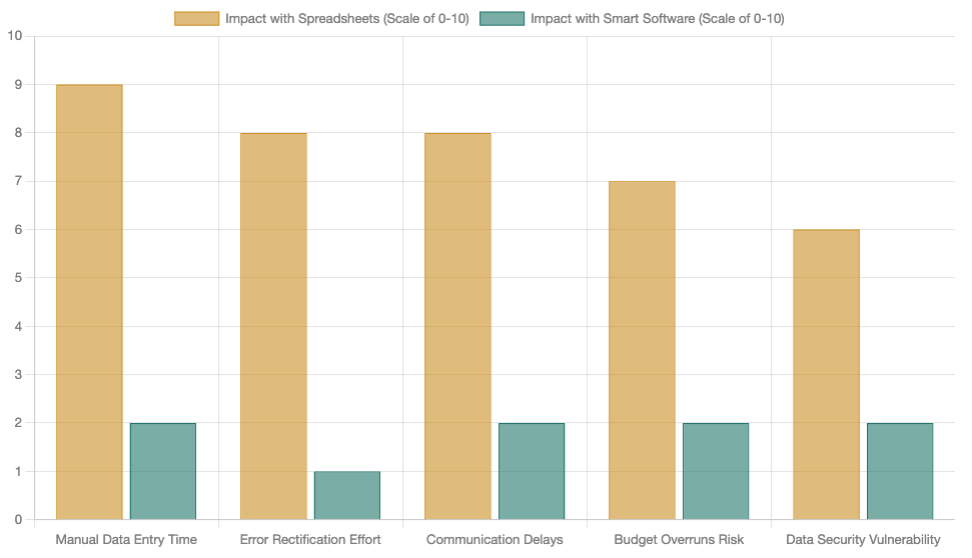
This bar chart illustrates the reduction in various project risks and inefficiencies when transitioning from spreadsheets to smart construction software.
A Few Thoughts on Culture and Context
Different regions, different ways of working, one adaptable solution.
It’s interesting, isn't it, how different regions have their own ways of doing things? North American crews often prefer fewer clicks and fewer meetings, just getting straight to it. European teams, on the other hand, tend to lean more towards structured workflows and robust audit trails. And then, GCC owners frequently require very tight compliance and extensive handover packages. Archdesk really supports all these styles without forcing a rigid mold. You set up workflows to match how your people actually build. That’s a quiet, but significant, win.
And let's not forget the seasonal reality. As weather windows get tighter and material lead times wobble (which they always seem to do!), the team that spots delays early, issues clear RFIs, and updates budgets the same day avoids frantic overtime later on. Summer or winter, that kind of rhythm genuinely pays off.
FAQ: Questions Leaders Often Ask
Will my team actually use it?
Honestly, if it saves them time on site and in the office, then yes, they will. Mobile tasks, simple RFIs, and clear budgets tend to do exactly that. When software genuinely makes their jobs easier, people embrace it.
How does this compare to our current setup?
If you’re currently juggling a separate tool for drawings, another for costs, and email for all your approvals, then you’re probably paying with a lot of wasted time and blind spots. Archdesk pulls all those flows together into one cohesive system.
What about integrations with other tools?
Archdesk connects with popular accounting software and common field tools. If you need a specific link, just ask; modern platforms, including Archdesk, support API-based connections to ensure everything works together smoothly.
Is this overkill for smaller jobs?
Not at all. Even smaller tenant improvements benefit immensely from controlled change orders, tidy RFIs, and clean closeouts. Having clear processes and documentation helps on projects of any size.
Conclusion: A Calm Call to Action
You don’t need fireworks. What you truly need are fewer surprises and healthier margins. Try moving just one project from spreadsheets to Archdesk. Feel the difference in three key areas: fewer moments of asking "which version is this?", faster visibility into your costs, and a smoother project closeout. If it doesn’t help, well, then stop. But if it does, then you can expand, confidently. You know what? That’s the most honest way to change how you manage your projects. Start small. Keep what works. Let the software handle the boring bits, so your people can truly focus on building.
References
Construction Platform vs Point Solution – Archdesk
The 15 Best Construction Management Software Tools in 2025
Construction Management Blog & Insights | Archdesk
The Rise of Smart Construction AI Trends You Can't Ignore ...
Better Alternative to Autodesk Construction Cloud | Archdesk





